Online Shopping Systems Evaluation: Customer and Retailer Analysis
VerifiedAdded on 2021/06/18
|27
|6747
|135
Report
AI Summary
This report provides a comprehensive evaluation of online shopping systems, focusing on both customer and retailer perspectives. The evaluation methodology involves usability testing with users from both groups, assessing their interactions with the system through specific tasks. The report details the use cases considered, including customer bidding, sign-up processes, product searches, order placement, payment methods, and feedback mechanisms. Retailer tasks involve inventory management, order fulfillment, and customer relationship management. The evaluation aims to assess system usability, identify errors, and gather user feedback on various aspects of the online shopping experience. The report analyzes quantitative data and user interviews to determine system performance and areas for improvement, covering aspects like login time, password strength, product search efficiency, payment processes, and user interface design. The findings will help to understand the strengths and weaknesses of the system from both customer and retailer viewpoints and provide insights for optimizing the online shopping experience.
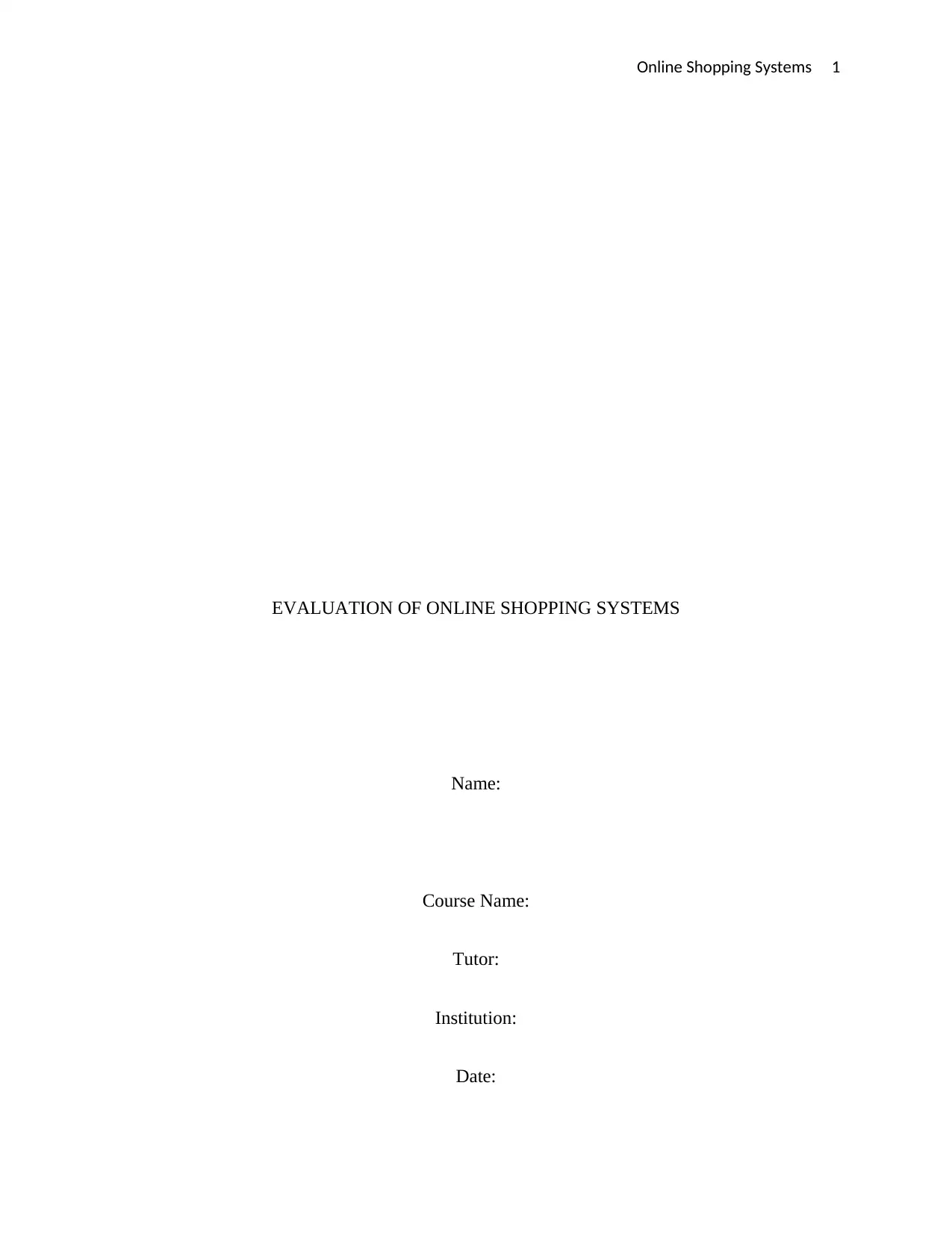
Online Shopping Systems 1
EVALUATION OF ONLINE SHOPPING SYSTEMS
Name:
Course Name:
Tutor:
Institution:
Date:
EVALUATION OF ONLINE SHOPPING SYSTEMS
Name:
Course Name:
Tutor:
Institution:
Date:
Paraphrase This Document
Need a fresh take? Get an instant paraphrase of this document with our AI Paraphraser
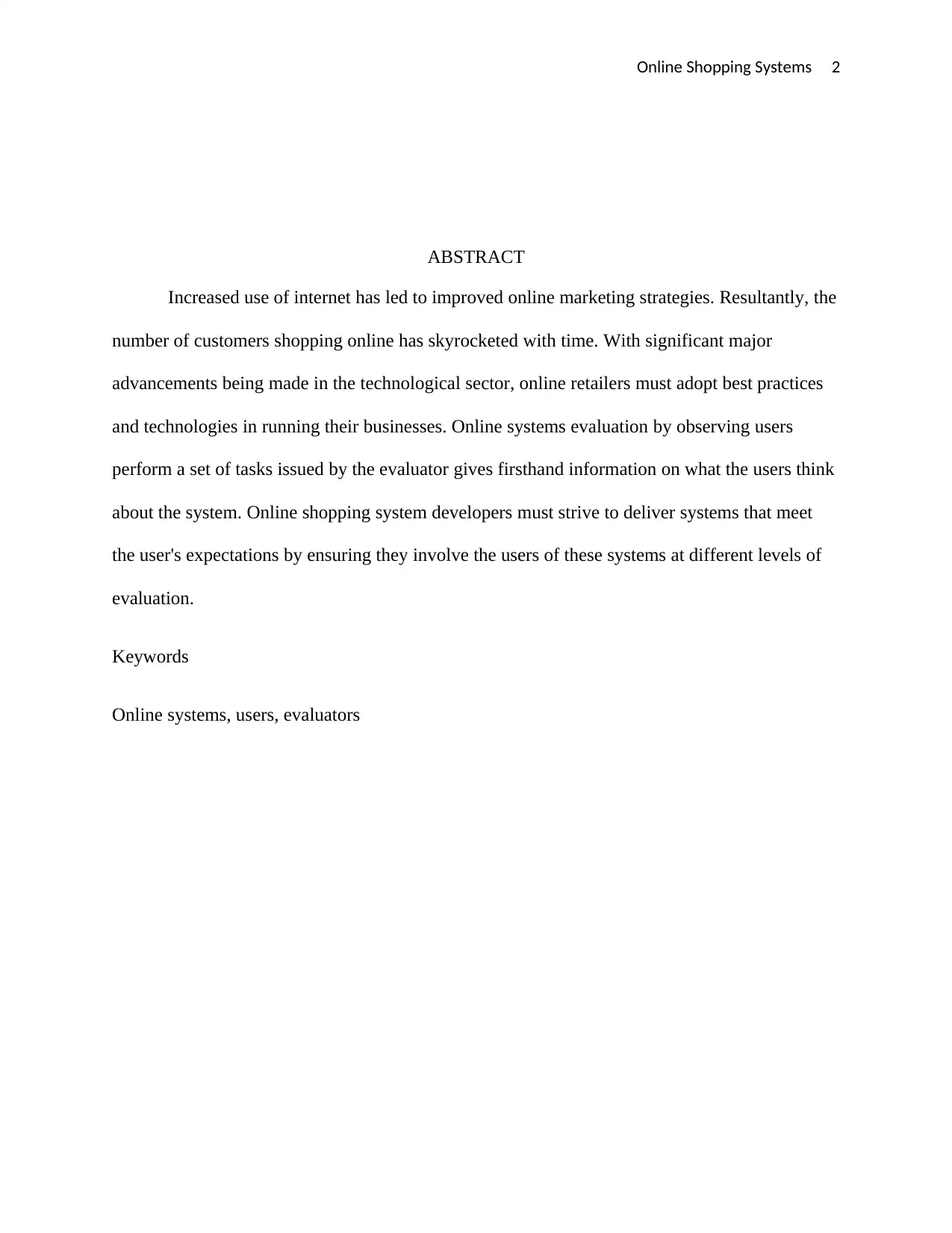
Online Shopping Systems 2
ABSTRACT
Increased use of internet has led to improved online marketing strategies. Resultantly, the
number of customers shopping online has skyrocketed with time. With significant major
advancements being made in the technological sector, online retailers must adopt best practices
and technologies in running their businesses. Online systems evaluation by observing users
perform a set of tasks issued by the evaluator gives firsthand information on what the users think
about the system. Online shopping system developers must strive to deliver systems that meet
the user's expectations by ensuring they involve the users of these systems at different levels of
evaluation.
Keywords
Online systems, users, evaluators
ABSTRACT
Increased use of internet has led to improved online marketing strategies. Resultantly, the
number of customers shopping online has skyrocketed with time. With significant major
advancements being made in the technological sector, online retailers must adopt best practices
and technologies in running their businesses. Online systems evaluation by observing users
perform a set of tasks issued by the evaluator gives firsthand information on what the users think
about the system. Online shopping system developers must strive to deliver systems that meet
the user's expectations by ensuring they involve the users of these systems at different levels of
evaluation.
Keywords
Online systems, users, evaluators
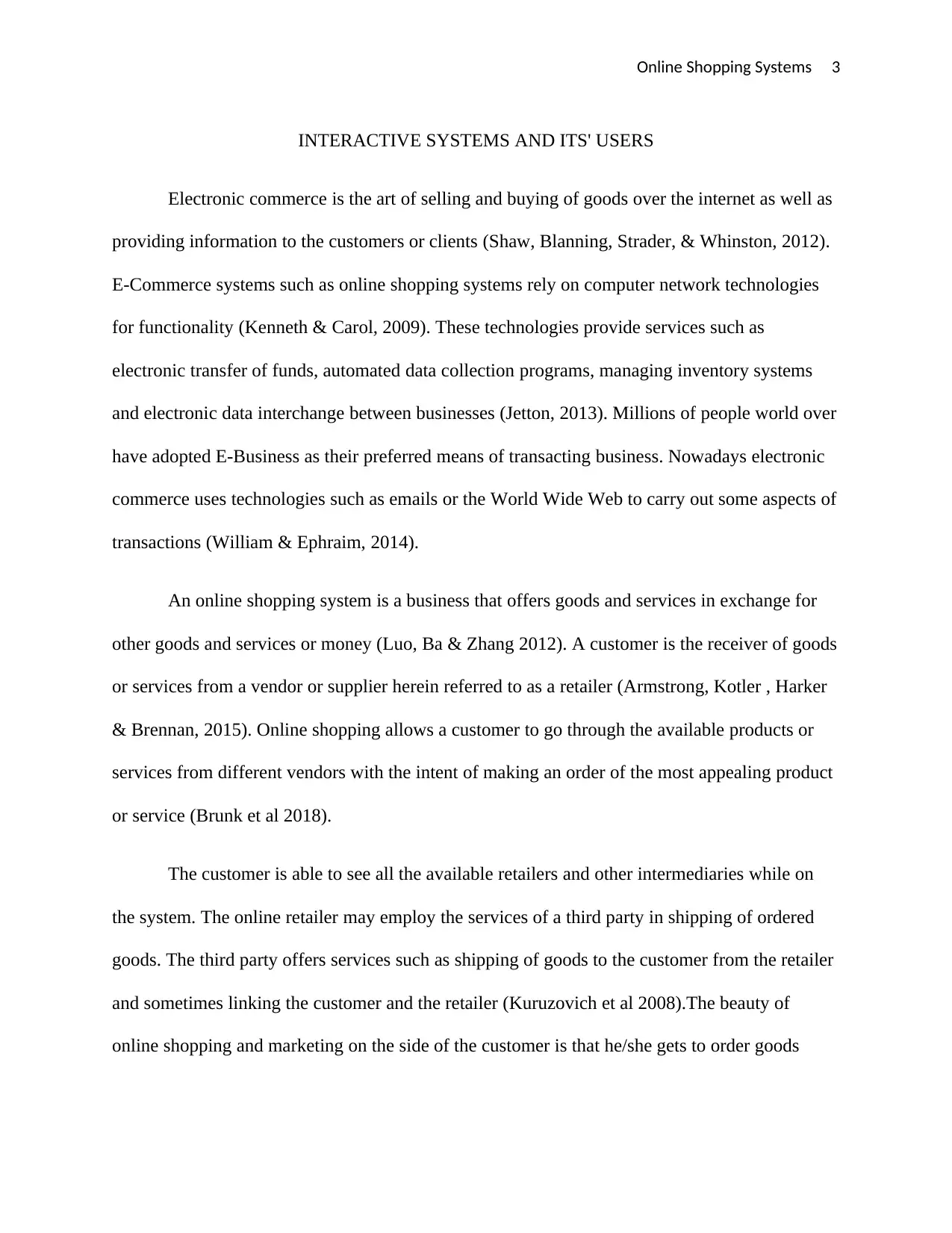
Online Shopping Systems 3
INTERACTIVE SYSTEMS AND ITS' USERS
Electronic commerce is the art of selling and buying of goods over the internet as well as
providing information to the customers or clients (Shaw, Blanning, Strader, & Whinston, 2012).
E-Commerce systems such as online shopping systems rely on computer network technologies
for functionality (Kenneth & Carol, 2009). These technologies provide services such as
electronic transfer of funds, automated data collection programs, managing inventory systems
and electronic data interchange between businesses (Jetton, 2013). Millions of people world over
have adopted E-Business as their preferred means of transacting business. Nowadays electronic
commerce uses technologies such as emails or the World Wide Web to carry out some aspects of
transactions (William & Ephraim, 2014).
An online shopping system is a business that offers goods and services in exchange for
other goods and services or money (Luo, Ba & Zhang 2012). A customer is the receiver of goods
or services from a vendor or supplier herein referred to as a retailer (Armstrong, Kotler , Harker
& Brennan, 2015). Online shopping allows a customer to go through the available products or
services from different vendors with the intent of making an order of the most appealing product
or service (Brunk et al 2018).
The customer is able to see all the available retailers and other intermediaries while on
the system. The online retailer may employ the services of a third party in shipping of ordered
goods. The third party offers services such as shipping of goods to the customer from the retailer
and sometimes linking the customer and the retailer (Kuruzovich et al 2008).The beauty of
online shopping and marketing on the side of the customer is that he/she gets to order goods
INTERACTIVE SYSTEMS AND ITS' USERS
Electronic commerce is the art of selling and buying of goods over the internet as well as
providing information to the customers or clients (Shaw, Blanning, Strader, & Whinston, 2012).
E-Commerce systems such as online shopping systems rely on computer network technologies
for functionality (Kenneth & Carol, 2009). These technologies provide services such as
electronic transfer of funds, automated data collection programs, managing inventory systems
and electronic data interchange between businesses (Jetton, 2013). Millions of people world over
have adopted E-Business as their preferred means of transacting business. Nowadays electronic
commerce uses technologies such as emails or the World Wide Web to carry out some aspects of
transactions (William & Ephraim, 2014).
An online shopping system is a business that offers goods and services in exchange for
other goods and services or money (Luo, Ba & Zhang 2012). A customer is the receiver of goods
or services from a vendor or supplier herein referred to as a retailer (Armstrong, Kotler , Harker
& Brennan, 2015). Online shopping allows a customer to go through the available products or
services from different vendors with the intent of making an order of the most appealing product
or service (Brunk et al 2018).
The customer is able to see all the available retailers and other intermediaries while on
the system. The online retailer may employ the services of a third party in shipping of ordered
goods. The third party offers services such as shipping of goods to the customer from the retailer
and sometimes linking the customer and the retailer (Kuruzovich et al 2008).The beauty of
online shopping and marketing on the side of the customer is that he/she gets to order goods
⊘ This is a preview!⊘
Do you want full access?
Subscribe today to unlock all pages.

Trusted by 1+ million students worldwide
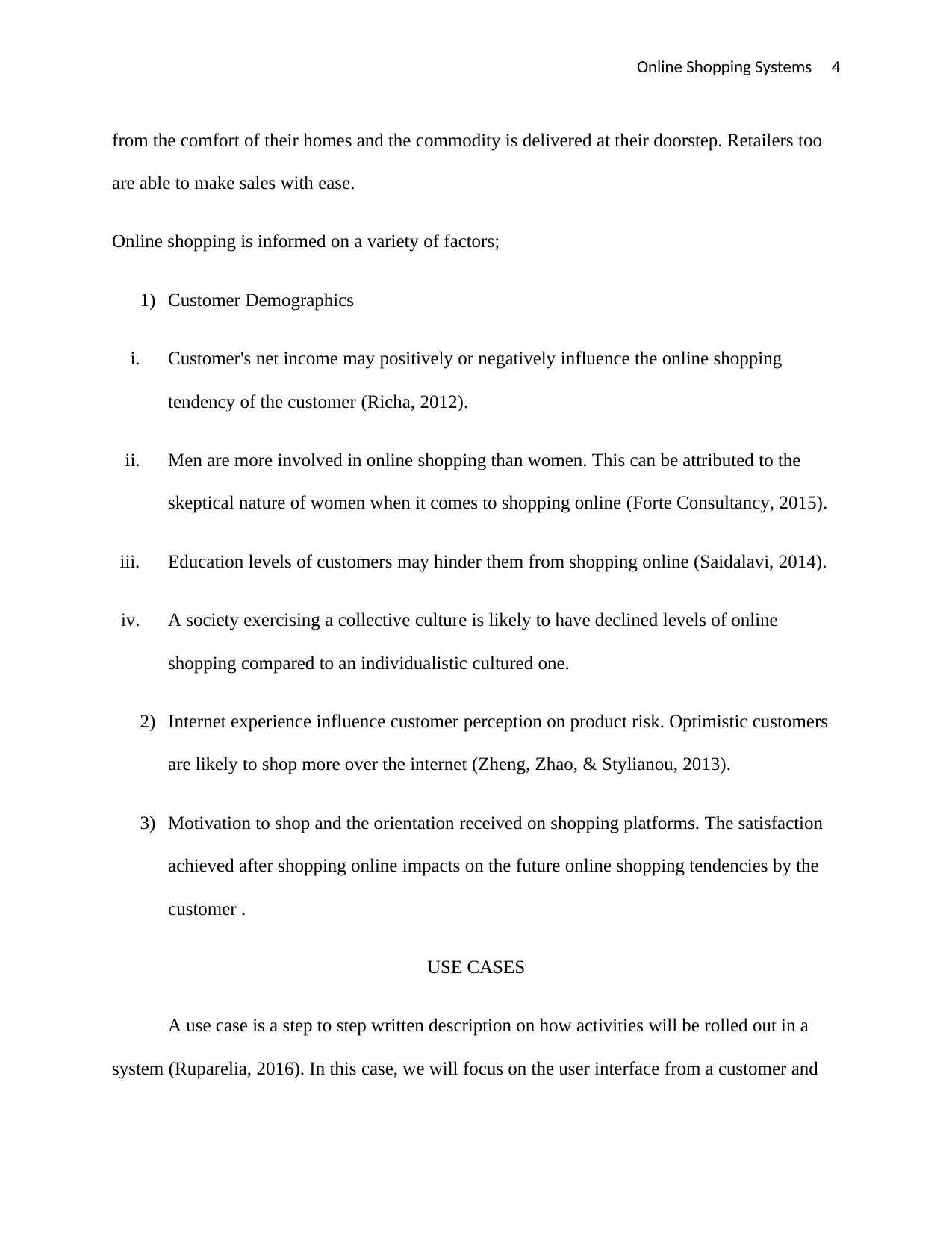
Online Shopping Systems 4
from the comfort of their homes and the commodity is delivered at their doorstep. Retailers too
are able to make sales with ease.
Online shopping is informed on a variety of factors;
1) Customer Demographics
i. Customer's net income may positively or negatively influence the online shopping
tendency of the customer (Richa, 2012).
ii. Men are more involved in online shopping than women. This can be attributed to the
skeptical nature of women when it comes to shopping online (Forte Consultancy, 2015).
iii. Education levels of customers may hinder them from shopping online (Saidalavi, 2014).
iv. A society exercising a collective culture is likely to have declined levels of online
shopping compared to an individualistic cultured one.
2) Internet experience influence customer perception on product risk. Optimistic customers
are likely to shop more over the internet (Zheng, Zhao, & Stylianou, 2013).
3) Motivation to shop and the orientation received on shopping platforms. The satisfaction
achieved after shopping online impacts on the future online shopping tendencies by the
customer .
USE CASES
A use case is a step to step written description on how activities will be rolled out in a
system (Ruparelia, 2016). In this case, we will focus on the user interface from a customer and
from the comfort of their homes and the commodity is delivered at their doorstep. Retailers too
are able to make sales with ease.
Online shopping is informed on a variety of factors;
1) Customer Demographics
i. Customer's net income may positively or negatively influence the online shopping
tendency of the customer (Richa, 2012).
ii. Men are more involved in online shopping than women. This can be attributed to the
skeptical nature of women when it comes to shopping online (Forte Consultancy, 2015).
iii. Education levels of customers may hinder them from shopping online (Saidalavi, 2014).
iv. A society exercising a collective culture is likely to have declined levels of online
shopping compared to an individualistic cultured one.
2) Internet experience influence customer perception on product risk. Optimistic customers
are likely to shop more over the internet (Zheng, Zhao, & Stylianou, 2013).
3) Motivation to shop and the orientation received on shopping platforms. The satisfaction
achieved after shopping online impacts on the future online shopping tendencies by the
customer .
USE CASES
A use case is a step to step written description on how activities will be rolled out in a
system (Ruparelia, 2016). In this case, we will focus on the user interface from a customer and
Paraphrase This Document
Need a fresh take? Get an instant paraphrase of this document with our AI Paraphraser
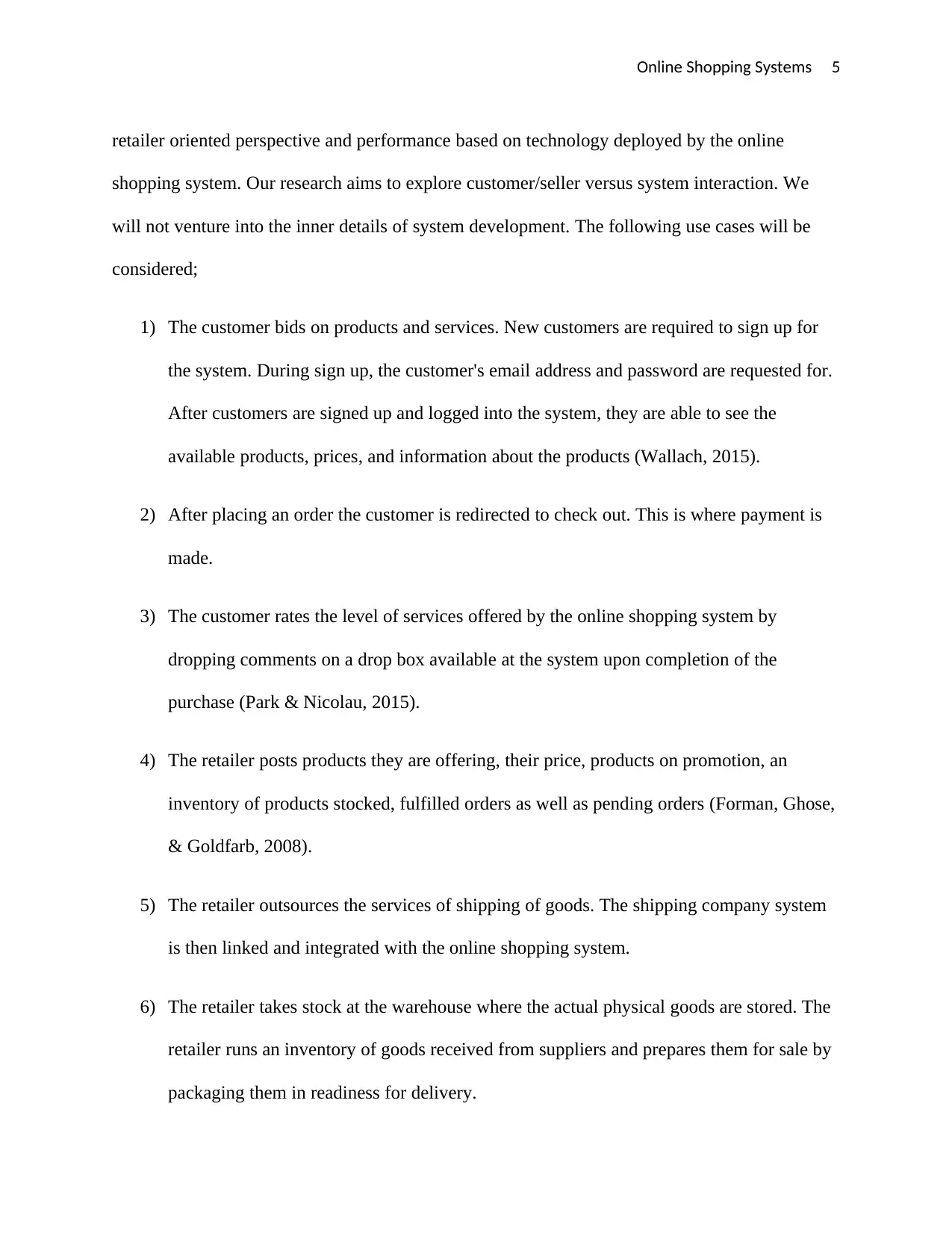
Online Shopping Systems 5
retailer oriented perspective and performance based on technology deployed by the online
shopping system. Our research aims to explore customer/seller versus system interaction. We
will not venture into the inner details of system development. The following use cases will be
considered;
1) The customer bids on products and services. New customers are required to sign up for
the system. During sign up, the customer's email address and password are requested for.
After customers are signed up and logged into the system, they are able to see the
available products, prices, and information about the products (Wallach, 2015).
2) After placing an order the customer is redirected to check out. This is where payment is
made.
3) The customer rates the level of services offered by the online shopping system by
dropping comments on a drop box available at the system upon completion of the
purchase (Park & Nicolau, 2015).
4) The retailer posts products they are offering, their price, products on promotion, an
inventory of products stocked, fulfilled orders as well as pending orders (Forman, Ghose,
& Goldfarb, 2008).
5) The retailer outsources the services of shipping of goods. The shipping company system
is then linked and integrated with the online shopping system.
6) The retailer takes stock at the warehouse where the actual physical goods are stored. The
retailer runs an inventory of goods received from suppliers and prepares them for sale by
packaging them in readiness for delivery.
retailer oriented perspective and performance based on technology deployed by the online
shopping system. Our research aims to explore customer/seller versus system interaction. We
will not venture into the inner details of system development. The following use cases will be
considered;
1) The customer bids on products and services. New customers are required to sign up for
the system. During sign up, the customer's email address and password are requested for.
After customers are signed up and logged into the system, they are able to see the
available products, prices, and information about the products (Wallach, 2015).
2) After placing an order the customer is redirected to check out. This is where payment is
made.
3) The customer rates the level of services offered by the online shopping system by
dropping comments on a drop box available at the system upon completion of the
purchase (Park & Nicolau, 2015).
4) The retailer posts products they are offering, their price, products on promotion, an
inventory of products stocked, fulfilled orders as well as pending orders (Forman, Ghose,
& Goldfarb, 2008).
5) The retailer outsources the services of shipping of goods. The shipping company system
is then linked and integrated with the online shopping system.
6) The retailer takes stock at the warehouse where the actual physical goods are stored. The
retailer runs an inventory of goods received from suppliers and prepares them for sale by
packaging them in readiness for delivery.
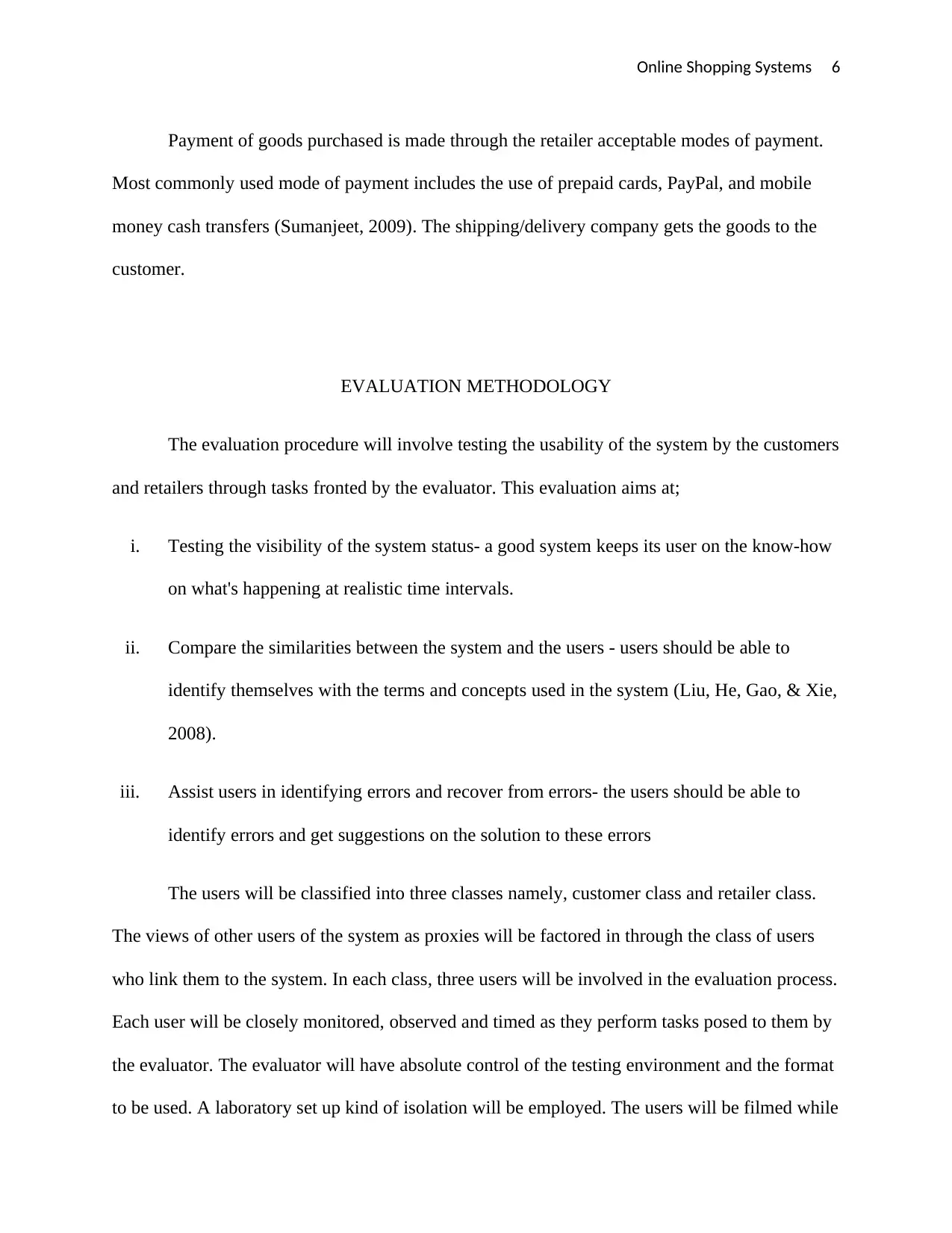
Online Shopping Systems 6
Payment of goods purchased is made through the retailer acceptable modes of payment.
Most commonly used mode of payment includes the use of prepaid cards, PayPal, and mobile
money cash transfers (Sumanjeet, 2009). The shipping/delivery company gets the goods to the
customer.
EVALUATION METHODOLOGY
The evaluation procedure will involve testing the usability of the system by the customers
and retailers through tasks fronted by the evaluator. This evaluation aims at;
i. Testing the visibility of the system status- a good system keeps its user on the know-how
on what's happening at realistic time intervals.
ii. Compare the similarities between the system and the users - users should be able to
identify themselves with the terms and concepts used in the system (Liu, He, Gao, & Xie,
2008).
iii. Assist users in identifying errors and recover from errors- the users should be able to
identify errors and get suggestions on the solution to these errors
The users will be classified into three classes namely, customer class and retailer class.
The views of other users of the system as proxies will be factored in through the class of users
who link them to the system. In each class, three users will be involved in the evaluation process.
Each user will be closely monitored, observed and timed as they perform tasks posed to them by
the evaluator. The evaluator will have absolute control of the testing environment and the format
to be used. A laboratory set up kind of isolation will be employed. The users will be filmed while
Payment of goods purchased is made through the retailer acceptable modes of payment.
Most commonly used mode of payment includes the use of prepaid cards, PayPal, and mobile
money cash transfers (Sumanjeet, 2009). The shipping/delivery company gets the goods to the
customer.
EVALUATION METHODOLOGY
The evaluation procedure will involve testing the usability of the system by the customers
and retailers through tasks fronted by the evaluator. This evaluation aims at;
i. Testing the visibility of the system status- a good system keeps its user on the know-how
on what's happening at realistic time intervals.
ii. Compare the similarities between the system and the users - users should be able to
identify themselves with the terms and concepts used in the system (Liu, He, Gao, & Xie,
2008).
iii. Assist users in identifying errors and recover from errors- the users should be able to
identify errors and get suggestions on the solution to these errors
The users will be classified into three classes namely, customer class and retailer class.
The views of other users of the system as proxies will be factored in through the class of users
who link them to the system. In each class, three users will be involved in the evaluation process.
Each user will be closely monitored, observed and timed as they perform tasks posed to them by
the evaluator. The evaluator will have absolute control of the testing environment and the format
to be used. A laboratory set up kind of isolation will be employed. The users will be filmed while
⊘ This is a preview!⊘
Do you want full access?
Subscribe today to unlock all pages.

Trusted by 1+ million students worldwide
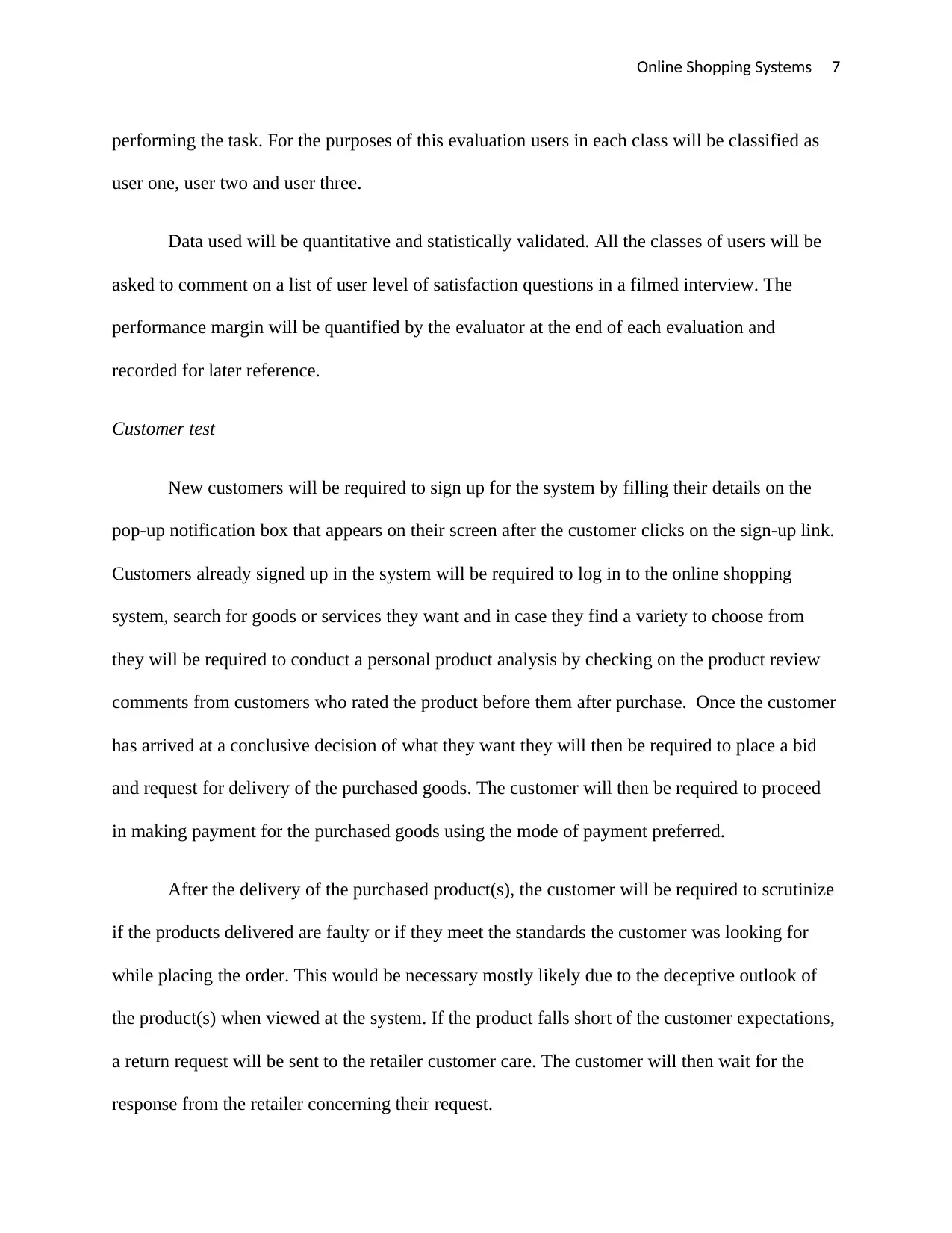
Online Shopping Systems 7
performing the task. For the purposes of this evaluation users in each class will be classified as
user one, user two and user three.
Data used will be quantitative and statistically validated. All the classes of users will be
asked to comment on a list of user level of satisfaction questions in a filmed interview. The
performance margin will be quantified by the evaluator at the end of each evaluation and
recorded for later reference.
Customer test
New customers will be required to sign up for the system by filling their details on the
pop-up notification box that appears on their screen after the customer clicks on the sign-up link.
Customers already signed up in the system will be required to log in to the online shopping
system, search for goods or services they want and in case they find a variety to choose from
they will be required to conduct a personal product analysis by checking on the product review
comments from customers who rated the product before them after purchase. Once the customer
has arrived at a conclusive decision of what they want they will then be required to place a bid
and request for delivery of the purchased goods. The customer will then be required to proceed
in making payment for the purchased goods using the mode of payment preferred.
After the delivery of the purchased product(s), the customer will be required to scrutinize
if the products delivered are faulty or if they meet the standards the customer was looking for
while placing the order. This would be necessary mostly likely due to the deceptive outlook of
the product(s) when viewed at the system. If the product falls short of the customer expectations,
a return request will be sent to the retailer customer care. The customer will then wait for the
response from the retailer concerning their request.
performing the task. For the purposes of this evaluation users in each class will be classified as
user one, user two and user three.
Data used will be quantitative and statistically validated. All the classes of users will be
asked to comment on a list of user level of satisfaction questions in a filmed interview. The
performance margin will be quantified by the evaluator at the end of each evaluation and
recorded for later reference.
Customer test
New customers will be required to sign up for the system by filling their details on the
pop-up notification box that appears on their screen after the customer clicks on the sign-up link.
Customers already signed up in the system will be required to log in to the online shopping
system, search for goods or services they want and in case they find a variety to choose from
they will be required to conduct a personal product analysis by checking on the product review
comments from customers who rated the product before them after purchase. Once the customer
has arrived at a conclusive decision of what they want they will then be required to place a bid
and request for delivery of the purchased goods. The customer will then be required to proceed
in making payment for the purchased goods using the mode of payment preferred.
After the delivery of the purchased product(s), the customer will be required to scrutinize
if the products delivered are faulty or if they meet the standards the customer was looking for
while placing the order. This would be necessary mostly likely due to the deceptive outlook of
the product(s) when viewed at the system. If the product falls short of the customer expectations,
a return request will be sent to the retailer customer care. The customer will then wait for the
response from the retailer concerning their request.
Paraphrase This Document
Need a fresh take? Get an instant paraphrase of this document with our AI Paraphraser
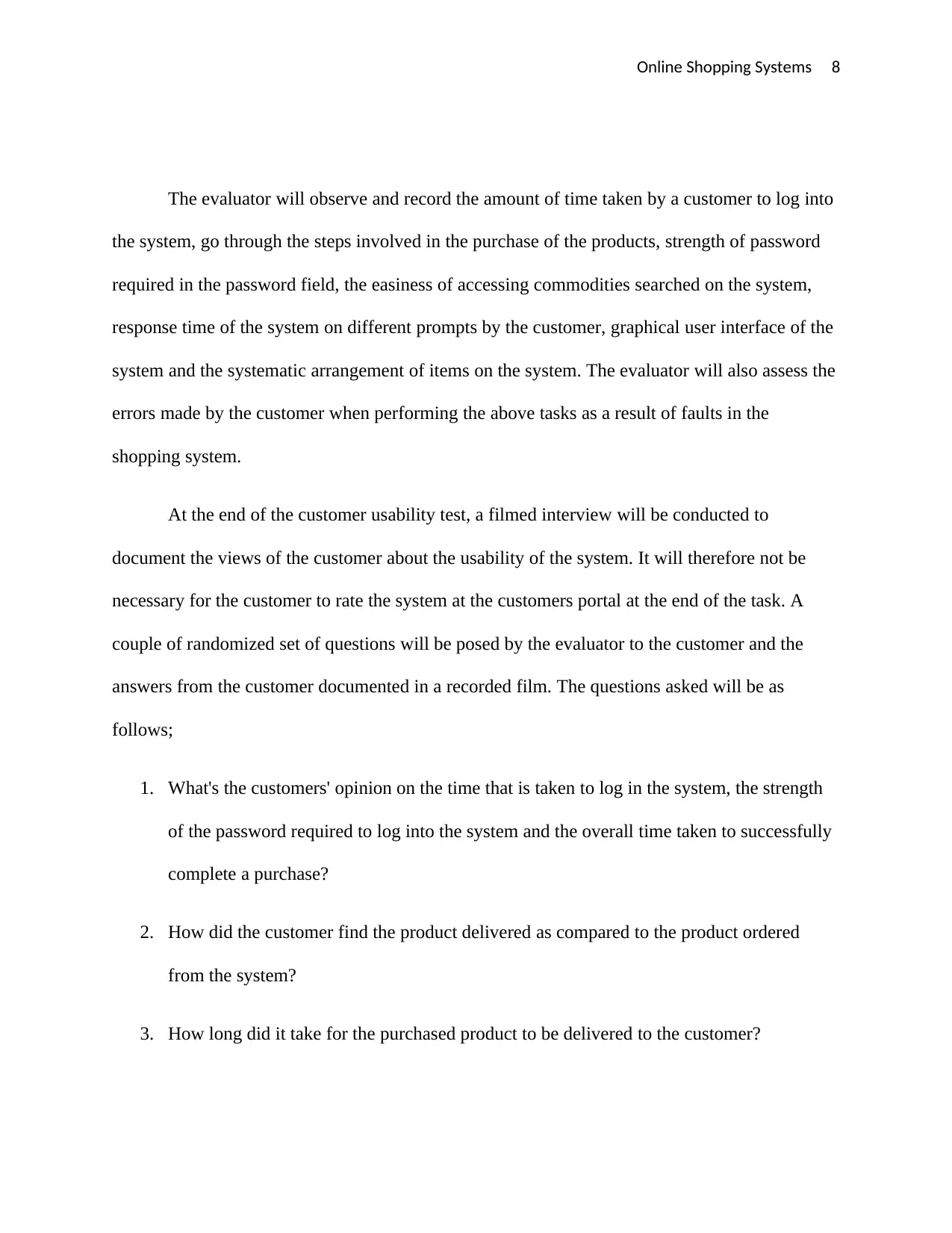
Online Shopping Systems 8
The evaluator will observe and record the amount of time taken by a customer to log into
the system, go through the steps involved in the purchase of the products, strength of password
required in the password field, the easiness of accessing commodities searched on the system,
response time of the system on different prompts by the customer, graphical user interface of the
system and the systematic arrangement of items on the system. The evaluator will also assess the
errors made by the customer when performing the above tasks as a result of faults in the
shopping system.
At the end of the customer usability test, a filmed interview will be conducted to
document the views of the customer about the usability of the system. It will therefore not be
necessary for the customer to rate the system at the customers portal at the end of the task. A
couple of randomized set of questions will be posed by the evaluator to the customer and the
answers from the customer documented in a recorded film. The questions asked will be as
follows;
1. What's the customers' opinion on the time that is taken to log in the system, the strength
of the password required to log into the system and the overall time taken to successfully
complete a purchase?
2. How did the customer find the product delivered as compared to the product ordered
from the system?
3. How long did it take for the purchased product to be delivered to the customer?
The evaluator will observe and record the amount of time taken by a customer to log into
the system, go through the steps involved in the purchase of the products, strength of password
required in the password field, the easiness of accessing commodities searched on the system,
response time of the system on different prompts by the customer, graphical user interface of the
system and the systematic arrangement of items on the system. The evaluator will also assess the
errors made by the customer when performing the above tasks as a result of faults in the
shopping system.
At the end of the customer usability test, a filmed interview will be conducted to
document the views of the customer about the usability of the system. It will therefore not be
necessary for the customer to rate the system at the customers portal at the end of the task. A
couple of randomized set of questions will be posed by the evaluator to the customer and the
answers from the customer documented in a recorded film. The questions asked will be as
follows;
1. What's the customers' opinion on the time that is taken to log in the system, the strength
of the password required to log into the system and the overall time taken to successfully
complete a purchase?
2. How did the customer find the product delivered as compared to the product ordered
from the system?
3. How long did it take for the purchased product to be delivered to the customer?
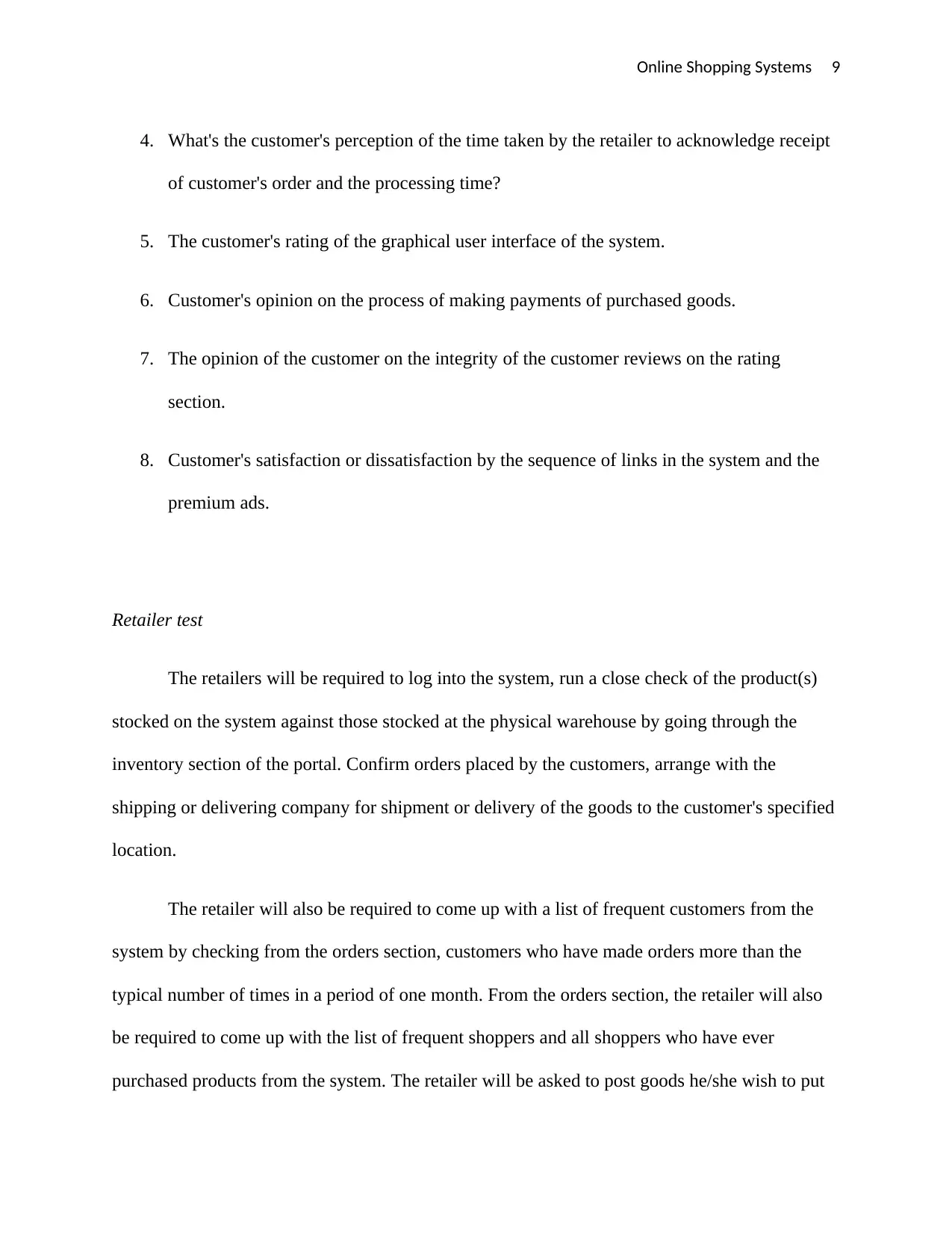
Online Shopping Systems 9
4. What's the customer's perception of the time taken by the retailer to acknowledge receipt
of customer's order and the processing time?
5. The customer's rating of the graphical user interface of the system.
6. Customer's opinion on the process of making payments of purchased goods.
7. The opinion of the customer on the integrity of the customer reviews on the rating
section.
8. Customer's satisfaction or dissatisfaction by the sequence of links in the system and the
premium ads.
Retailer test
The retailers will be required to log into the system, run a close check of the product(s)
stocked on the system against those stocked at the physical warehouse by going through the
inventory section of the portal. Confirm orders placed by the customers, arrange with the
shipping or delivering company for shipment or delivery of the goods to the customer's specified
location.
The retailer will also be required to come up with a list of frequent customers from the
system by checking from the orders section, customers who have made orders more than the
typical number of times in a period of one month. From the orders section, the retailer will also
be required to come up with the list of frequent shoppers and all shoppers who have ever
purchased products from the system. The retailer will be asked to post goods he/she wish to put
4. What's the customer's perception of the time taken by the retailer to acknowledge receipt
of customer's order and the processing time?
5. The customer's rating of the graphical user interface of the system.
6. Customer's opinion on the process of making payments of purchased goods.
7. The opinion of the customer on the integrity of the customer reviews on the rating
section.
8. Customer's satisfaction or dissatisfaction by the sequence of links in the system and the
premium ads.
Retailer test
The retailers will be required to log into the system, run a close check of the product(s)
stocked on the system against those stocked at the physical warehouse by going through the
inventory section of the portal. Confirm orders placed by the customers, arrange with the
shipping or delivering company for shipment or delivery of the goods to the customer's specified
location.
The retailer will also be required to come up with a list of frequent customers from the
system by checking from the orders section, customers who have made orders more than the
typical number of times in a period of one month. From the orders section, the retailer will also
be required to come up with the list of frequent shoppers and all shoppers who have ever
purchased products from the system. The retailer will be asked to post goods he/she wish to put
⊘ This is a preview!⊘
Do you want full access?
Subscribe today to unlock all pages.

Trusted by 1+ million students worldwide
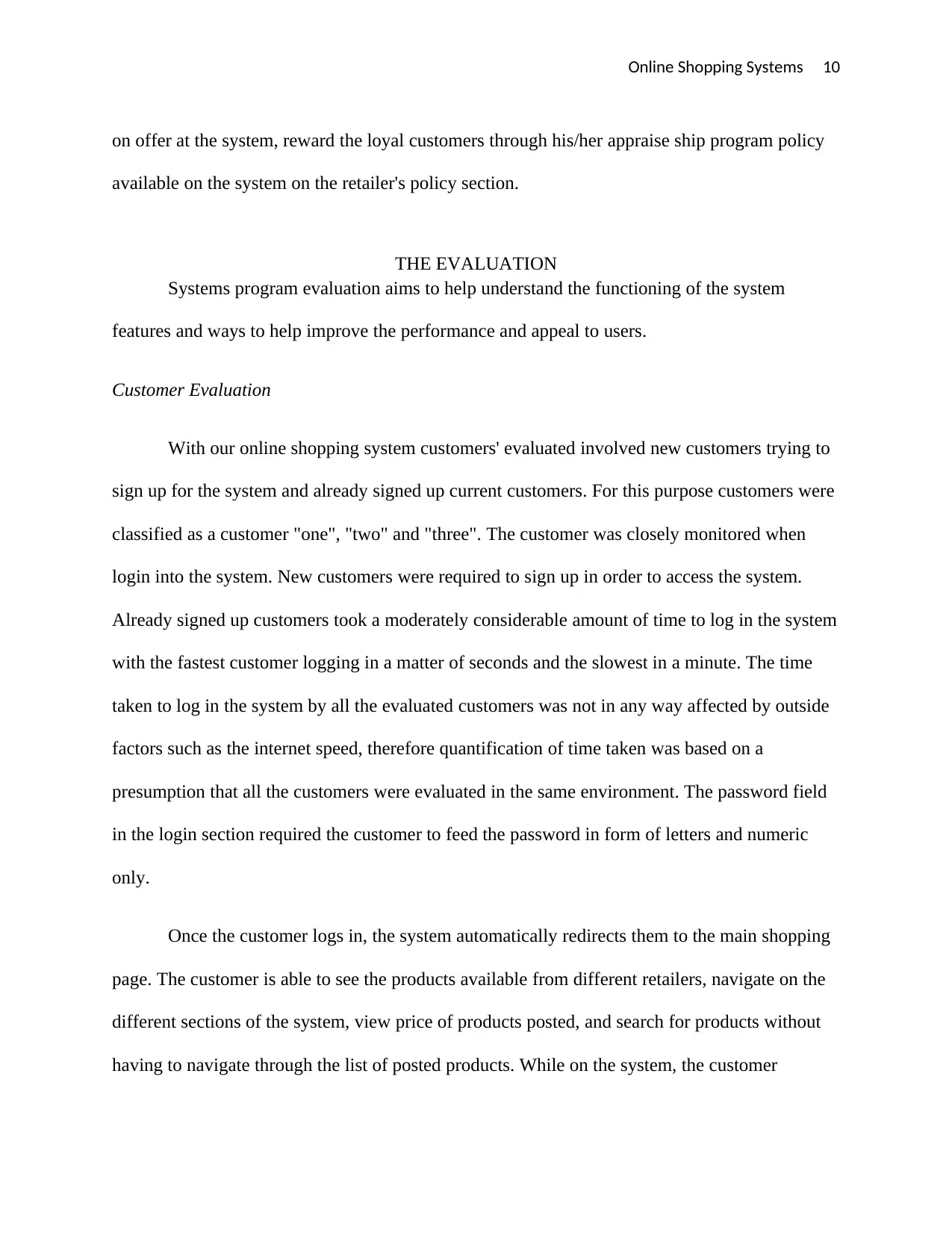
Online Shopping Systems 10
on offer at the system, reward the loyal customers through his/her appraise ship program policy
available on the system on the retailer's policy section.
THE EVALUATION
Systems program evaluation aims to help understand the functioning of the system
features and ways to help improve the performance and appeal to users.
Customer Evaluation
With our online shopping system customers' evaluated involved new customers trying to
sign up for the system and already signed up current customers. For this purpose customers were
classified as a customer "one", "two" and "three". The customer was closely monitored when
login into the system. New customers were required to sign up in order to access the system.
Already signed up customers took a moderately considerable amount of time to log in the system
with the fastest customer logging in a matter of seconds and the slowest in a minute. The time
taken to log in the system by all the evaluated customers was not in any way affected by outside
factors such as the internet speed, therefore quantification of time taken was based on a
presumption that all the customers were evaluated in the same environment. The password field
in the login section required the customer to feed the password in form of letters and numeric
only.
Once the customer logs in, the system automatically redirects them to the main shopping
page. The customer is able to see the products available from different retailers, navigate on the
different sections of the system, view price of products posted, and search for products without
having to navigate through the list of posted products. While on the system, the customer
on offer at the system, reward the loyal customers through his/her appraise ship program policy
available on the system on the retailer's policy section.
THE EVALUATION
Systems program evaluation aims to help understand the functioning of the system
features and ways to help improve the performance and appeal to users.
Customer Evaluation
With our online shopping system customers' evaluated involved new customers trying to
sign up for the system and already signed up current customers. For this purpose customers were
classified as a customer "one", "two" and "three". The customer was closely monitored when
login into the system. New customers were required to sign up in order to access the system.
Already signed up customers took a moderately considerable amount of time to log in the system
with the fastest customer logging in a matter of seconds and the slowest in a minute. The time
taken to log in the system by all the evaluated customers was not in any way affected by outside
factors such as the internet speed, therefore quantification of time taken was based on a
presumption that all the customers were evaluated in the same environment. The password field
in the login section required the customer to feed the password in form of letters and numeric
only.
Once the customer logs in, the system automatically redirects them to the main shopping
page. The customer is able to see the products available from different retailers, navigate on the
different sections of the system, view price of products posted, and search for products without
having to navigate through the list of posted products. While on the system, the customer
Paraphrase This Document
Need a fresh take? Get an instant paraphrase of this document with our AI Paraphraser
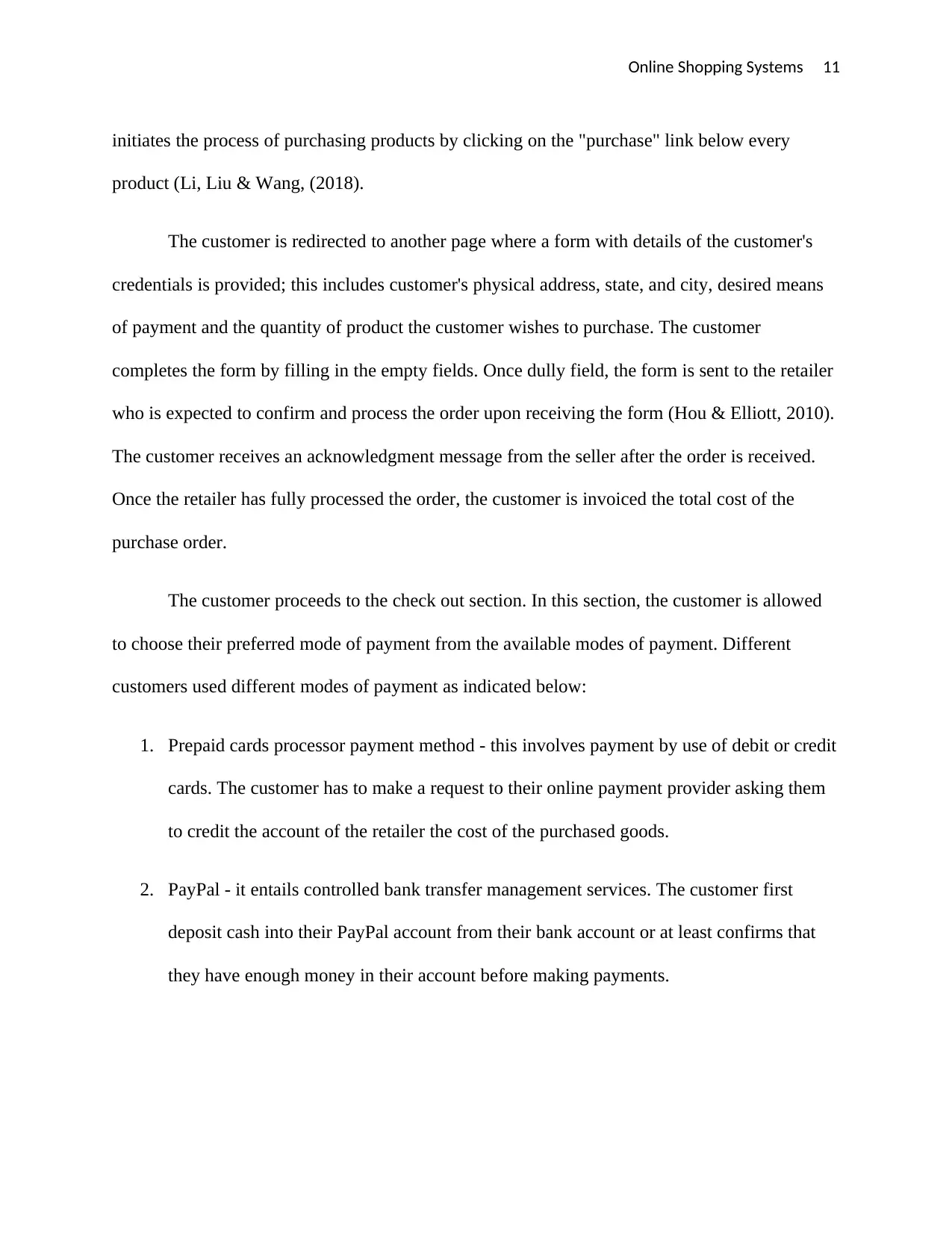
Online Shopping Systems 11
initiates the process of purchasing products by clicking on the "purchase" link below every
product (Li, Liu & Wang, (2018).
The customer is redirected to another page where a form with details of the customer's
credentials is provided; this includes customer's physical address, state, and city, desired means
of payment and the quantity of product the customer wishes to purchase. The customer
completes the form by filling in the empty fields. Once dully field, the form is sent to the retailer
who is expected to confirm and process the order upon receiving the form (Hou & Elliott, 2010).
The customer receives an acknowledgment message from the seller after the order is received.
Once the retailer has fully processed the order, the customer is invoiced the total cost of the
purchase order.
The customer proceeds to the check out section. In this section, the customer is allowed
to choose their preferred mode of payment from the available modes of payment. Different
customers used different modes of payment as indicated below:
1. Prepaid cards processor payment method - this involves payment by use of debit or credit
cards. The customer has to make a request to their online payment provider asking them
to credit the account of the retailer the cost of the purchased goods.
2. PayPal - it entails controlled bank transfer management services. The customer first
deposit cash into their PayPal account from their bank account or at least confirms that
they have enough money in their account before making payments.
initiates the process of purchasing products by clicking on the "purchase" link below every
product (Li, Liu & Wang, (2018).
The customer is redirected to another page where a form with details of the customer's
credentials is provided; this includes customer's physical address, state, and city, desired means
of payment and the quantity of product the customer wishes to purchase. The customer
completes the form by filling in the empty fields. Once dully field, the form is sent to the retailer
who is expected to confirm and process the order upon receiving the form (Hou & Elliott, 2010).
The customer receives an acknowledgment message from the seller after the order is received.
Once the retailer has fully processed the order, the customer is invoiced the total cost of the
purchase order.
The customer proceeds to the check out section. In this section, the customer is allowed
to choose their preferred mode of payment from the available modes of payment. Different
customers used different modes of payment as indicated below:
1. Prepaid cards processor payment method - this involves payment by use of debit or credit
cards. The customer has to make a request to their online payment provider asking them
to credit the account of the retailer the cost of the purchased goods.
2. PayPal - it entails controlled bank transfer management services. The customer first
deposit cash into their PayPal account from their bank account or at least confirms that
they have enough money in their account before making payments.
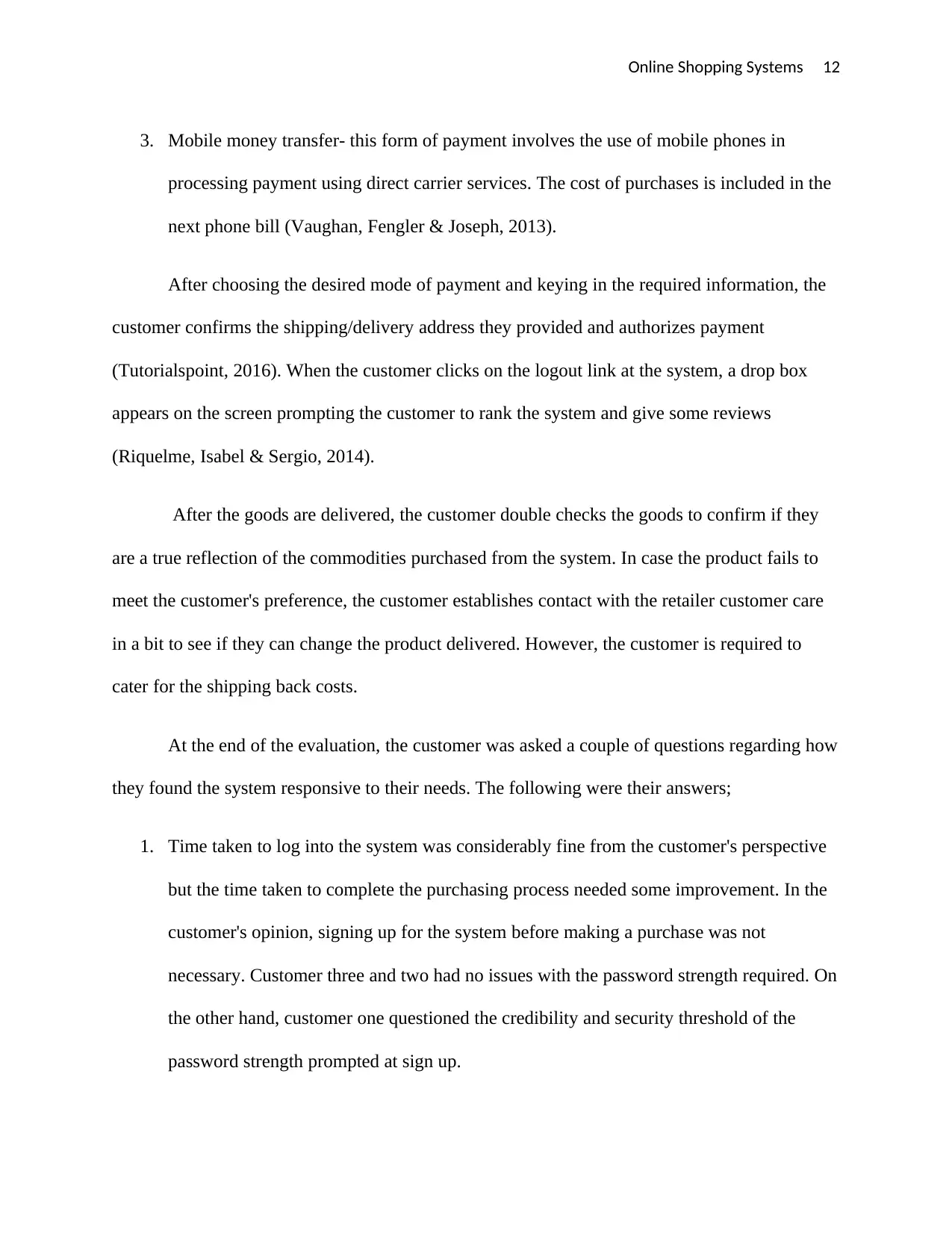
Online Shopping Systems 12
3. Mobile money transfer- this form of payment involves the use of mobile phones in
processing payment using direct carrier services. The cost of purchases is included in the
next phone bill (Vaughan, Fengler & Joseph, 2013).
After choosing the desired mode of payment and keying in the required information, the
customer confirms the shipping/delivery address they provided and authorizes payment
(Tutorialspoint, 2016). When the customer clicks on the logout link at the system, a drop box
appears on the screen prompting the customer to rank the system and give some reviews
(Riquelme, Isabel & Sergio, 2014).
After the goods are delivered, the customer double checks the goods to confirm if they
are a true reflection of the commodities purchased from the system. In case the product fails to
meet the customer's preference, the customer establishes contact with the retailer customer care
in a bit to see if they can change the product delivered. However, the customer is required to
cater for the shipping back costs.
At the end of the evaluation, the customer was asked a couple of questions regarding how
they found the system responsive to their needs. The following were their answers;
1. Time taken to log into the system was considerably fine from the customer's perspective
but the time taken to complete the purchasing process needed some improvement. In the
customer's opinion, signing up for the system before making a purchase was not
necessary. Customer three and two had no issues with the password strength required. On
the other hand, customer one questioned the credibility and security threshold of the
password strength prompted at sign up.
3. Mobile money transfer- this form of payment involves the use of mobile phones in
processing payment using direct carrier services. The cost of purchases is included in the
next phone bill (Vaughan, Fengler & Joseph, 2013).
After choosing the desired mode of payment and keying in the required information, the
customer confirms the shipping/delivery address they provided and authorizes payment
(Tutorialspoint, 2016). When the customer clicks on the logout link at the system, a drop box
appears on the screen prompting the customer to rank the system and give some reviews
(Riquelme, Isabel & Sergio, 2014).
After the goods are delivered, the customer double checks the goods to confirm if they
are a true reflection of the commodities purchased from the system. In case the product fails to
meet the customer's preference, the customer establishes contact with the retailer customer care
in a bit to see if they can change the product delivered. However, the customer is required to
cater for the shipping back costs.
At the end of the evaluation, the customer was asked a couple of questions regarding how
they found the system responsive to their needs. The following were their answers;
1. Time taken to log into the system was considerably fine from the customer's perspective
but the time taken to complete the purchasing process needed some improvement. In the
customer's opinion, signing up for the system before making a purchase was not
necessary. Customer three and two had no issues with the password strength required. On
the other hand, customer one questioned the credibility and security threshold of the
password strength prompted at sign up.
⊘ This is a preview!⊘
Do you want full access?
Subscribe today to unlock all pages.

Trusted by 1+ million students worldwide
1 out of 27
Related Documents
Your All-in-One AI-Powered Toolkit for Academic Success.
+13062052269
info@desklib.com
Available 24*7 on WhatsApp / Email
![[object Object]](/_next/static/media/star-bottom.7253800d.svg)
Unlock your academic potential
Copyright © 2020–2025 A2Z Services. All Rights Reserved. Developed and managed by ZUCOL.





